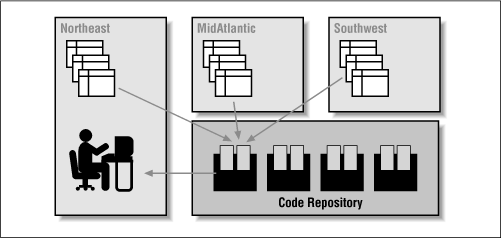3.2 The Invoker Rights Model
, rules and restrictions, AUTHID DEFINER clause, DELETE statement, INSERT statement, SELECT statement, UPDATE statement, LOCK TABLE transaction control statement, OPEN cursor control statement, OPEN-FOR statement, native dynamic SQL, EXECUTE IMMEDIATE statement, native dynamic SQL, PARSE procedure, DBMS_SQL package">
3.2 The Invoker Rights Model To help developers get around the obstacles raised by the definer rights model, Oracle 8.1 offers an alternative: the invoker rights model. With this approach, all external references in a PL/SQL program unit are resolved according to the directly-granted privileges of the invoking schema, not the owning or defining schema. Figure 3.3 demonstrates the fundamental difference between the definer and the invoker rights models. Recall that in Figure 3.2, it was necessary for me to push out copies of my application to each regional office so that the code would manipulate the correct tables. Figure 3.3. Use of invoker rights model to allow a "pass through" to user data With invoker rights, this step is no longer necessary. Now I can compile the code into a single code repository. When a user from the Northeast region executes the centralized program (probably via a synonym), it will automatically work with tables in the Northeast schema. So that's the idea behind invoker rights. Let's see what is involved codewise, and then explore how best to exploit the feature. 3.2.1 Invoker Rights SyntaxThe syntax to support this feature is simple enough. You add the following clause before your IS or AS keyword in the program header: AUTHID CURRENT_USER Here, for example, is a generic "run DDL" engine that relies on the new Oracle 8.1 native dynamic SQL statement EXECUTE IMMEDIATE (described in Chapter 4 ) and the invoker rights model: CREATE OR REPLACE PROCEDURE runddl (ddl_in in VARCHAR2) AUTHID CURRENT_USER IS BEGIN EXECUTE IMMEDIATE ddl_in; END; / That's certainly lots simpler than the earlier implementation, isn't it? The AUTHID CURRENT_USER clause before the IS keyword indicates that when runddl executes, it should run under the authority of the invoker or "current user," not the authority of the definer. And that's all you have to do. If you do not include the AUTHID clause or if you include it and explicitly request definer rights as shown: AUTHID DEFINER then all references in your program will be resolved according to the directly granted privileges of the owning schema. 3.2.2 Some Rules and RestrictionsThere are a number of rules and restrictions to keep in mind when you are taking advantage of the invoker rights model:
|
| | |
| Team-Fly |
| Top |
EAN: N/A
Pages: 107
- ERP System Acquisition: A Process Model and Results From an Austrian Survey
- Enterprise Application Integration: New Solutions for a Solved Problem or a Challenging Research Field?
- Distributed Data Warehouse for Geo-spatial Services
- A Hybrid Clustering Technique to Improve Patient Data Quality
- Development of Interactive Web Sites to Enhance Police/Community Relations
